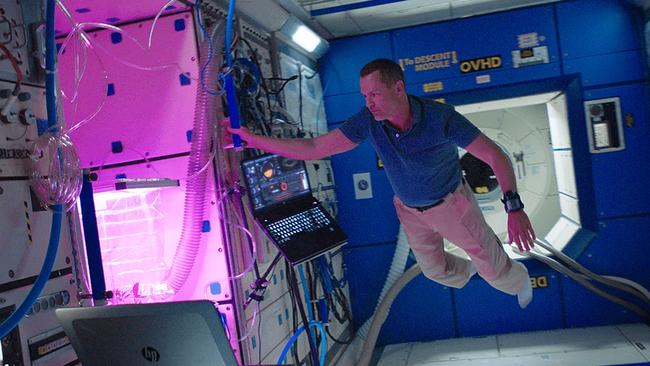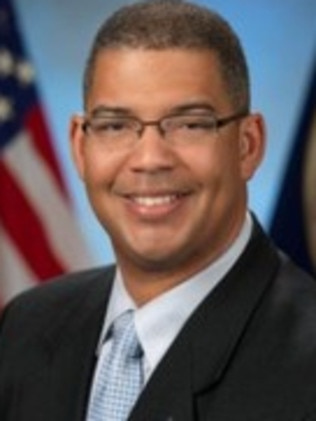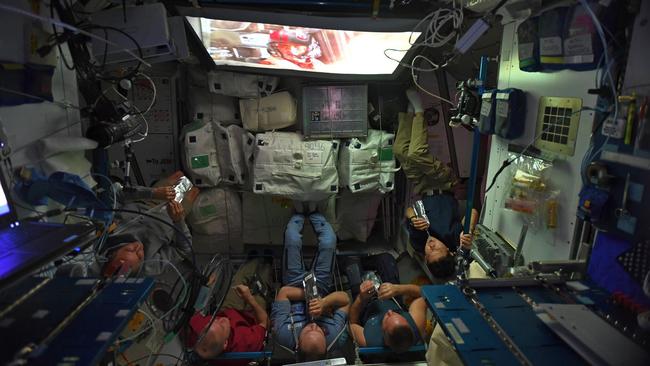READING LEVEL: ORANGE
If you think it would be difficult to stay in touch from Earth with an astronaut* on the International Space Station*, you’d be very, very wrong.
It’s actually quite easy and doesn’t take fancy equipment or millions of dollars.
When astronauts want to call home they use a phone, when they want to listen to music they use an iPod and if they want to answer a tricky question, they google it on their laptop or tablet just like you would at home.
In fact, our space explorers on the International Space Station (ISS) have never been more connected to the world 408km below them thanks to an innovative* program by NASA* and HP.

In a recent visit to Australia, Stephen Hunter, who is NASA’s manager of the ISS’s computer resources, said keeping astronauts in touch with their families and work friends was important to their overall wellbeing* and mental health* in space.
“Mentally you have to give up a lot of things when you are in space, but we do have to give them (astronauts) a way to communicate,” Mr Hunter said.
“They cannot have a cell phone (mobile), but we help provide some very personal items for them …. such as Ipods and IP phones (which use the internet) to call anywhere in the world.
“They can do video conferencing and soon will have technology similar to Skype,” he said.
It is Mr Hunter’s job to find ways to bring technology on board and has been working on a program to use everyday technology products— such as HP Z-book laptops and HP printers which you can buy in any store — to help lower the cost for NASA.
“The space station is now very data* driven so we use approximately 100 laptops to service all the needs,” Mr Hunter said.

The laptops help power scientific tasks, engineering, testing, operations and entertainment.
He said using devices for the astronauts to be able to talk with family, hear music and relax was important to stop them feeling isolated.
“They watch movies. They have a projector* and large screen they use so they can watch TV and watch movies.”
And are they limited to a set number of movies they take up with them?
“No, they are watching what we do down here. They can live stream anything up there,” Mr Hunter said.

Mr Hunter said he never imagined working for NASA as a kid and originally studied to be a doctor.
He quickly realised it wasn’t for him and ended up at NASA as a coder*. Now he looks after how the ISS command and control systems work.
After almost 26 years with the space agency, Mr Hunter said it was wonderful to see how ordinary people doing different jobs could help send people into space to explore the universe.
“When you think about putting someone into space, it takes people from every field* and every endeavour*,” Mr Hunter said.
“We have people with backgrounds in business, transport services, financial management*, legal to handle the different laws and contracts, engineers*, mechanics*, health specialists, geologists* and natural scientists.
“It definitely takes a lot of different fields,” he said.
GLOSSARY
astronaut: a person who is trained to travel in a spacecraft
International Space Station: large spacecraft in orbit around Earth where astronauts live
innovative: new ideas and creative thinking
NASA: National Aeronautics and Space Administration in the US
wellbeing: being healthy and happy
mental health: the health of your mind and emotions
data: facts and statistics often collected by a computer
projector: a device that shows images on a screen
coder: a person who writes computer programs
field: articular interest or job
endeavour: pursuit of an activity
financial management: managing money and how it is spent or saved
engineers: people who designs, builds, or maintains engines, machines, or structures
mechanics: workers who repair and maintain vehicles and engines
geologists: experts in geology (study of rocks)
LISTEN TO TODAY’S STORY
QUICK QUIZ
1. How far above Earth is the International Space Station?
2. Why is it important for NASA to provide devices to keep astronauts in touch with people on Earth?
3. Can you name some of the reasons why there up about 100 computers on board the International Space Station?
4. What are some of the ways astronauts can feel connected to Earth when they are in space?
5. Is it only astronauts that can work on the space program? Explain your answer.
CLASSROOM ACTIVITY
Questions for an astronaut
Astronauts on the ISS have access to video conferencing! If you were able to speak to one of the astronauts aboard the shuttle face-to-face what would you talk to them about? Make a list of things you would ask them? Two questions should be about their professional roles on the shuttle, two questions should be about how they spend their spare time in space and one question should be for them to show or demonstrate something that you think would be interesting. Make sure that the questions you ask are open-ended ones that the astronauts could give a detailed answer to. (That means no ‘yes’ or ‘no’ answer questions!)
Extension: Find out more about the ISS. Write down 5 fascinating facts that you discover.
Time: Allow 25 minutes
Curriculum links: English, Science, Personal and Social Capability
VCOP ACTIVITY
With a partner see if you can you identify all the doing words/verbs in this text? Highlight them in yellow and then make a list of them all down your page. Now see if you and your partner can come up with a synonym for the chosen verb- make sure it still makes the context it was taken from.
Try and see if you can replace some of the original verbs with your synonyms and discuss if any are better and why.
Curriculum Links: English, Big Write and VCOP
IN ONE SENTENCE, TELL US WHAT YOU LIKE ABOUT TODAY’S STORY
Please do not use one-word answers. Explain what you enjoyed or found interesting about the article. Use lots of adjectives.

Can you spot secret passport art?
If you have a recently issued passport, take a closer look. At first glance, the 17 iconic Australian landscapes are beautiful to behold. But hidden shapes start to appear under a certain type of lighting
What time is it on the moon?
Tick tock: NASA to create a time standard for the moon to help spacecraft from around the world synchronise their clocks